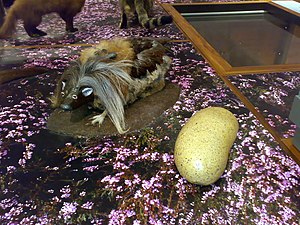
Summary
Wild haggis (given the humorous taxonomic designation Haggis scoticus) is a fictional creature of Scottish folklore,[2] said to be native to the Scottish Highlands.[1][3] It is comically claimed to be the source of haggis, a traditional Scottish dish that is in fact made from the innards of sheep (including heart, lungs, and liver).[4]

According to some sources, the wild haggis's left and right legs are of different lengths (cf. Sidehill gouger or Dahu), allowing it to run quickly around the steep mountains and hillsides which make up its natural habitat, but only in one direction.[2][3] It is further claimed that there are two varieties of haggis, one with longer left legs and the other with longer right legs. The former variety can run clockwise around a mountain (as seen from above) while the latter can run anticlockwise.[5] The two varieties coexist peacefully but are unable to interbreed in the wild because in order for the male of one variety to mate with a female of the other, he must turn to face in the same direction as his intended mate, causing him to lose his balance before he can mount her. As a result of this difficulty, differences in leg length among the haggis population are accentuated.[3]
Haggis abroad edit
The notion of the wild haggis is widely believed, though not always including the idea of mismatched legs. According to an online survey commissioned by haggis manufacturers Hall's of Broxburn, released on 26 November 2003, one-third of U.S. visitors to Scotland believed the wild haggis to be a real creature.[4][6]
See also edit
- Sidehill gouger
- Dahu, another fictional animal also said to exist in "clockwise" and "anticlockwise" varieties
- Jackalope
- Wolpertinger
- Drop bear
- Tree octopus
References edit
- ^ a b Kelvingrove Art Gallery and Museum in The New York Times, accessed 9 February 2009 (Archived 21 February 2009 at the Wayback Machine)
- ^ a b Jonathan Green, Scottish Miscellany: Everything You Always Wanted to Know about Scotland the Brave, p. 128
- ^ a b c A. M. King, L. Cromarty, C. Paterson, J. S. Boyd, "Applications of ultrasonography in the reproductive management of Dux magnus gentis venteris saginati", BMUS Bulletin (British Medical Ultrasound Society), Vol. 10, no.2, 2002
- ^ a b John Carvel, "Majestic haggis of the glens proves elusive for US tourists" in The Guardian, Thursday 27 November 2003 02.18
- ^ Wild Haggis at Undiscovered Scotland.co.uk, accessed 9 February 2009
- ^ "US tourists want to hunt wild haggis" in The Sydney Morning Herald, 27 November 2003


